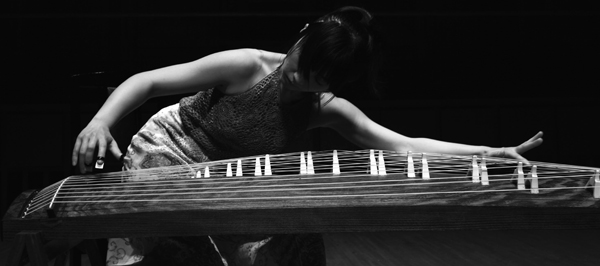
|
|
Arts at Tenri presents
Friday, May 8, 2009, 8:00 pm
In Between Traditional &
Contemporary
Yumi
Kurosawa – Koto
Guest Artist: Marianna
Rosett, Piano

Program
- Green-Point (2006) composed by Yumi Kurosawa
- Inner Space (2002) composed by Yumi Kurosawa
- MIDARE (1661~1673) composed by by Kengyo Yatsuhashi
- Amazing Grace (traditional)
- SAKURA Variation composed by Bondai Fujii
- Summertime composed by George Gershwin, arranged by Yumi Kurosawa
- MUGONKA (2009) composed by Takashi Niigaki - World Premiere
- One Girl's Story - for Story Teller (2008) composed by Yumi Kurosawa
- Rapture - Independent Shot Animated Film (2003) composed by Yumi Kurosawa
- Improvisation by Koto and Piano, Yumi Kurosawa and Marianna Rosett
Yumi Kurosawa has had extensive performances in Japan
include worldwide concert tours to Canada, Germany, Malaysia, Russia,
and United States. In 2002, Kurosawa moved to New York in pursuit of new
innovative collaborations with artists and musicians. 2009 : Performed
in live music performance "LIFE AFTER DARK" at Apollo Theater
SalonSeries. 2008: Performed HANA ICHIMOMME at Bank Street Theater, NYC
*Performed at APRU (Asian Pacific Rim University) annual meeting ceremony
in Tokyo, Japan *Lectured on Art Cart Education Program(Lecture concert
for family) at Japan Society, NYC *Ensemble East Concert at Eastman School
of Music 2007: *Performed at Pulse Jazz Composers : Sihr Halal Concert
at Roulette, NYC *Performed at Hogakuten Concert in Tokyo, Japan *Performed
at Muse concert at The Juilliard School(Played solo and with Orchestra)
2006: *Joint recital with Dozan Fujiwara(Shakuhachi) in Yamagata, Japan
*Yumi Kurosawa Koto Recital at Weill Recital Hall at Carnegie Hall 2005:
*Meredith Monk 40th Anniversary Concert at Zankel Hall at Carnegie Hall
*Theater [Deadly She Wolf Assassin at Armagedon] at Japan Society, NYC
and Philadelphia 2000:*Performed on NHK Broadcast TV program [Genjimonogatari-Wakana]
Tokyo, Japan 1993:* Performed with Evjan Rattai of Prague Cello Ensemble
at Suntory Hall in Tokyo, Japan 1989, '92:*Received First Prize in National
Koto competition for students, Japan. She studied Koto under Chikako &
Kazuo Kurosawa, Nanae Yoshimura and Sosui Yoshimura. Her CD will be released
in 2009. www.myspace.com/yumikurosawakoto
Born in Transylvania Romania. Pianist and composer Marianna Rosett
is at the forefront of classical improvisation today. She performs solo
recitals internationally, composes for film, dance and television. Former
Juilliard faculty she gives master classes in improvisation and teaches
in New York. New CD & Book will be released in 2009. Ms. Rosett holds
a B.S. and Master degree from the Juilliard school. www.myspace.com/mariannarosett
The Koto is a string instrument that originated in China and
came to Japan in the 7th-8th century. The Japanese koto is a large instrument,
about six feet long, consisting of a hollow body made from Paulownia wood
(kiri). Underneath the body are two sound holes, one at each end. There
are 13 strings each the same size and same tension. Movable bridges, called
a ji, are placed along the length of each string. The ji lift the strings
off of the body so that they will resonate when plucked. The strings are
tuned by sliding the movable bridges back and forth.
At first the koto was used only in court life but, later it was played
mainly by blind musicians. (Almost all Japanese pre-modern music was played
by blind musicians or monks and court people.) In the17th century (Edo
period), Yatsuhashi Kengyo (1614-1685), a blind koto master, succeeded
in making the koto a solo instrument by composing many new pieces for
the instrument. Thus he is known as the father of modern koto music. In
the 20th century, Michio Miyagi (1894-1956,) who was also a blind koto
player, modernized the koto yet again by introducing western styles of
music in his compositions.
The Place
Tenri Cultural Institute
43A West 13th Street, New York, NY
(212) 645-2800
Tickets

25 general, 20 students/seniors